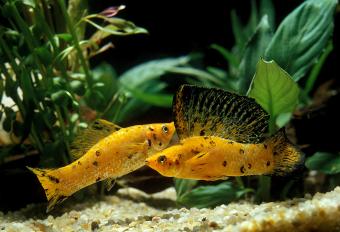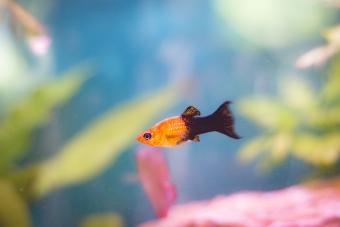
If you have an interest in guppies, it is probably only a matter of time before you become interested in rearing guppy fry yourself. Find out how to do it right in this exclusive interview with guppy expert Luke Roebuck.
About Luke Roebuck
Luke Roebuck was a favorite show judge with the International Fancy Guppy Association. He raised guppies for over 40 years and showed them for over 17 years. During his time raising guppies he had over 250 tanks where he raised show guppies to ship all over the world. Luke shared some of his knowledge on what it takes to rear guppy fry to healthy, beautiful adults.
Rearing Guppy Fry
According to Luke, "Guppy fry are relatively easy to raise." Recommendations include:
- Giving them a tank of their own away from adults or older fry from a different batch.
- Feeding at least three times per day with high-quality growth foods.
- At least one feeding should be live baby Artemia (brine shrimp) or other suitable small live foods.
Feeding Guppy Fry
Live artemia can be hatched daily from cyst eggs and fed to all fish. Feeding from fry to adults does not change appreciably. Luke advised that, "Most good breeders tend to feed fry more often (up to six to ten times per day), and they feed the fry more live food than they do the adults because the first three months are critical for body building. We feed newly hatched artemia from newborn to death."
Housing Guppy Fry
Many breeders separate their young by sex as early as they can maybe (two weeks after birth). Fry can be housed temporarily in one-gallon containers, but "they should be moved as soon as possible after a week or two to a larger tank to allow room to grow and for the better water quality afforded."

Equipment for Guppy Fry Breeders
Many breeders separate pregnant females into small containers they use for breeding tanks. Luke said he used breeding traps which allow the young to escape the mother and keep her cannibalizing her young. The newborn fry fall through small mesh openings in the trap and can live safely in the breeding container during the birthing process and after the trap with the mother is removed.

Avoid Heavy Fry Protection Traps
Luke related that, "Some breeders use heavy fry protection instead of traps, which tend to cause claustrophobic stress on mothers and they can and do jump out!" The containers are tightly covered except for a small feeding opening cut in the cover.
Common Guppy Fry Concerns
Luke expressed caution to potential breeders about more common problems with raising guppy fry:
- "Early culling for deformities is important, and the overall health and strength of the fry should be observed on a daily basis.
- Carefully observe and assess the stress level and health of the fry by observing their feeding and swimming activity. Occasionally the fry may be born weak from a stressed mother, especially if she was shipped very pregnant.
- Fry born to a new guppy owner in different water and food environment should be monitored closely for signs of stress, clamped fins, etc. This can also occur when moving fry to a new tank. Sometimes the addition of salt and cycle starter to the new tank can alleviate this problem."
Tips for Raising Guppies
"Guppies can be a labor of love or work depending on your objectives, attitude and focus," said Luke.
Use Multiple Tanks
He noted that "all involve multiple tanks, and this is a labor-intensive hobby if you want to produce top-quality fish." If you are looking to only have one tank of fish, this is not the hobby for you: "You cannot maintain high-quality guppies in only one tank. If fry are left to grow up together with the parents, they usually don't realize their best growth potential and become stunted by the toxic pheromones emitted by the older fish with their waste products."
Guppy Raisers Vs. Breeders
"Many of us experienced breeders separate guppy hobbyists into guppy raisers and guppy breeders," said Luke.
- Luke considered "raisers" to be people who, "can feed, clean and rear guppies and their mass-produced fry with good husbandry practices."
- On the other hand, a breeder not only raises guppies, but "has some basic genetic knowledge and understanding of guppy strains, phenotypes and genotypes ... to develop and improve strains and create new pedigreed strains."
Developments in Guppy Fry Breeding
As a result of the work of guppy breeders, guppies have developed into countless strains and now come in every color of the rainbow. Luke said, "With the help of the Internet, hobbyists and breeders world-wide have been able to communicate and share not only the hobby knowledge, but the strains as well."
Luke reported that there are breeding centers and associations worldwide which maintain strains, breeds and show guppies based on local show development standards. These include:
- International Kuratorium of Guppy Highbreeding (IKGH) focuses on breeding standards in the European region.
- International Fancy Guppy Association (IFGA) has affiliate clubs throughout the United States and Brazil.
Each of these regions have created strains of guppies or maintained variations from traditional guppy breeding regions. Through the Internet, these hobbyists have connected over the last decade and more to exchange most aspects their practices. As a result Luke said, "We can obtain strains from all over the world that were previously only known to the local areas where they were bred."
Learn More About Guppies
To learn more about guppies, check out the Pan Pacific Guppy Association's website. You can also visit Luke's website, which while no longer maintained, does have helpful articles for show guppy breeders and raisers. Another excellent resource is the International Fancy Guppy Association's website with information on basic care and breeding of show guppies.







